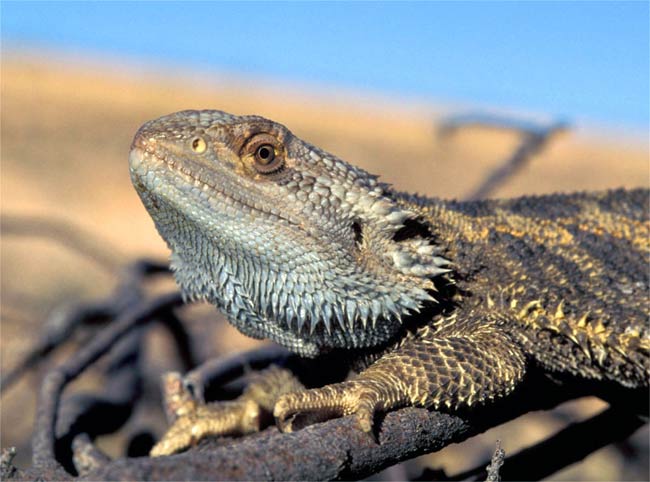Warming Climate Reverses Sex of Lizards

High temperatures can reverse the sex of dragon lizards before they hatch, turning males into females.
The finding, detailed in the April 20 issue of the journal Science, could have implications for the development of life as the planet's climate warms.
The research reveals that extreme temperatures could inactivate a gene on the male sex chromosomes of dragon lizards and thus turn male embryos into females. The sex-reversed lizards look female and have female organs but genetically they are male, said lead author Alexander Quinn of the University of Canberra in Australia.
Sex 101
Until now, scientists have assumed that the sex of mammalian and reptilian offspring is determined by either genes on sex chromosomes or external factors such as temperature, but not both at once. Genetics was thought to direct the sex of Australian central bearded dragon lizards (Pogona vitticeps).
Sexual reproduction involves the joining of sex cells, sperm and egg, each of which carries a set of chromosomes, including a sex-determining chromosome.
In most mammals, including humans, females have two X (sex) chromosomes , while males have one X and one Y. For the dragon lizard, the sex chromosomes are labeled as Z or W and females have dissimilar chromosomes (ZW), and males have matching ones (ZZ).
Get the world’s most fascinating discoveries delivered straight to your inbox.
So it was thought that the female determined the sex of the offspring, the opposite of the case in humans. Here’s why: If a dragon lizard egg cell containing a W chromosome is fertilized, the resulting zygote will be ZW (or female) while if a Z egg cell gets fertilized , the result will be ZZ (or male). What the egg cell brings to the table determines the sex outcome.
To test this, Quinn and his colleagues from the Australian National University incubated Pogona vitticeps eggs at constant temperatures, ranging from 68 to 99 degrees Fahrenheit (20 to 37 degrees Celsius).
No embryos survived at the coldest temperature. In ideal conditions, between 72 to 90 degrees Fahrenheit (22 and 32 degrees Celsius), an equal mix of male and female lizards developed. However, when the mercury soared to between 93 and 99 degrees Fahrenheit (34 and 37 degrees Celsius), significantly more females resulted, indicating that temperature trumped gene-controlled sex determination.
It's a girl
The scientists examined the baby lizards' physical features, including their sex organs, to label each as being outwardly, or "phenotypically," female or male. They also analyzed the lizards' DNA for female-specific markers linked to the W chromosome.
Nearly 100 percent of the eggs incubated at intermediate temperatures developed into lizards with genes that matched their physical features. However, about half of the lizards from high-temperature incubators had a mismatched make-up, in which genetic males "looked like" females.
"High temperature during the development of the embryos prevented the male DNA triggering testis development," Quinn told LiveScience. "By default, they developed instead as females with ovaries."
The scientists hypothesize that a gene on the Z chromosome—not the female W chromosome—triggers male development. They suggest a protein expressed by this gene is sensitive to temperature. "At most temperatures the protein is working at its best, but high temperatures make it less effective, making it unable to trigger male development," Quinn said.
Climate change
The results suggest that an interaction between temperature and genetics steers sex development in central bearded lizards.
Before now, scientists have been concerned about how global warming will affect sex ratios in species such as alligators and marine turtles, where temperature alone drives the sex of offspring.
"But now our study opens up the possibility that many [genetically sex-determined] reptiles might face the same risk as well, if they show reversal to 100 percent of one sex at high temperatures, like the bearded dragon,” Quinn said.
How these animals will adapt to global warming is a complex and open question. “Obviously, reptiles with temperature influences in their sex determination must have persisted through many climatic fluctuations throughout their evolutionary history," he said, "but a concern is that the current rate of climate warming might be too fast for these animals to adapt to it."
- Global Warming Could Doom Male Crocodiles
- Female Komodo Dragon Has Virgin Births
- Images: Snakes, Lizards and Frogs
Jeanna Bryner is managing editor of Scientific American. Previously she was editor in chief of Live Science and, prior to that, an editor at Scholastic's Science World magazine. Bryner has an English degree from Salisbury University, a master's degree in biogeochemistry and environmental sciences from the University of Maryland and a graduate science journalism degree from New York University. She has worked as a biologist in Florida, where she monitored wetlands and did field surveys for endangered species, including the gorgeous Florida Scrub Jay. She also received an ocean sciences journalism fellowship from the Woods Hole Oceanographic Institution. She is a firm believer that science is for everyone and that just about everything can be viewed through the lens of science.
 Live Science Plus
Live Science Plus





